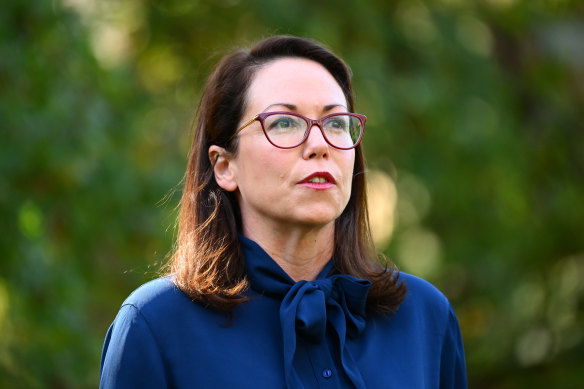By Lachlan Abbott
The rate of youth crime in Victoria reached its highest level in a decade last year, prompting new warnings from police about the number of children committing violent offences as the government prepares to raise the age of criminal responsibility.
Crime Statistics Agency figures released on Thursday showed children aged 14 to 17 were responsible for 18,729 criminal incidents last year – that age group’s highest rate of offending since 2009, according to Victoria Police.
Older teenagers were involved in more serious offending during 2023, with crimes against the person, assaults, aggravated burglaries, car thefts and robberies all rising.
“Much of the child and youth offending we’re seeing is mindless and driven by the pursuit of notoriety or social media likes,” Deputy Commissioner Neil Paterson said.
“This is highlighted by the fact that police recovered 94 per cent of vehicles stolen during aggravated burglaries as part of Operation Trinity – cars stolen purely for joyriding and no financial gain.”
Police said aggravated residential burglary – commonly involving children entering unlocked homes to steal car keys – was one of Victoria’s most concerning crime trends “due to the fear it instils in the community and danger it creates on our roads”.
The youth crime surge has intensified scrutiny on the state government’s commitment to eventually lift the age of criminal responsibility to 14 – as recommended by a Victorian coroner – starting with raising the age to 12 later this year.
Chief Commissioner Shane Patton said police still wanted to use courts to tackle crime among Victoria’s youngest offenders but acknowledged the cohort aged under 12 – which will soon not be held criminally responsible – was small.
“We can live with that,” he told ABC Radio.
The new figures showed criminal incident rates for 10 and 11-year-olds were lower than 2016 levels, but increases in older teenagers committing crimes outweighed this and pushed overall child offending to a decade high.
But Patton argued against raising the age of criminal responsibility to 14, using the crime figures as ammunition.
“Twelve and 13-year-olds commit very significant offences, and we need to be able to hold them to account for community safety and take them before the court. So we haven’t supported that,” he said.
The police union has also agitated for the government to drop this second stage of the age changes.
Police highlighted repeat youth offenders as a particular concern, with one in five committing three or more offences on separate occasions, an increase of 19 per cent from 2022. The recidivists included 198 under the age of 14 and 24 aged 10 or 11.
Any move by the state government to backtrack on raising the age of criminal responsibility to 14 would anger Indigenous and law reform advocates.
On Wednesday, they slammed Premier Jacinta Allan and Attorney-General Jaclyn Symes for ditching plans to give children the presumption of bail – the state government’s second recent U-turn on the youth justice reforms.
RMIT University criminologist Marietta Martinovic said higher youth crime rates should not be a surprise because social problems lingered, citing prevention programs as a proven way to better engage children and tackle offending.
She urged the state government to ignore pressure to scrap its plan to raise criminal responsibility to 14 by 2027.
“Please don’t, and think again,” Martinovic said.
“If we put them onto the trajectory of punishment, we are really going down the completely wrong road, where we will engage them early in the criminal justice system. And that will just perpetuate the offending cycle.
“There are no short-term, quick, cheap solutions to this.”
Opposition police and youth justice spokesman Brad Battin urged the government to reconsider its plans for changing criminal responsibility.

Victorian Attorney-General Jaclyn Symes.Credit: AAP
“[It’s] something that in the future I think we should be talking about, but it’s not the right time,” he said. “Right now we’ve got an increase in crimes in that 10 to 14-year cohort.”
On Wednesday, Symes told the ABC there had been no policy change.
“Our commitment is raising to 12 this year, with a commitment to raise to 14 – subject to the development of an alternative service model and a consideration of whether there’s serious offences that you would exclude from the criminal responsibility changes,” Symes said.
Police Minister Anthony Carbines said the rise in youth crime identified in the new statistics was similar to increases in other states.
“The Allan government’s No.1 priority is community safety,” he said, citing recent legislation to strengthen a prohibition on children having machetes and to confiscate assets of organised criminals.
“There’s always more to do. And we will provide every resource and effort that Victoria Police need for the work they do to hold perpetrators to account.”
Police said last year’s true overall crime rate – which factors in Victoria’s population growth – was 7698.2 offences per 100,000 people. That’s up 5.6 per cent from 2022, but is still 6.1 per cent lower than in 2019.
“Crime in Victoria has gradually increased over the past few years as Victorian life has returned to normality post-pandemic,” Paterson said.
Crime Statistics Agency chief statistician Fiona Dowsley said increases in high-volume property and deception offences – particularly thefts from motor vehicles and retail stores – drove the continued uptick in overall crime.
“An increase in these acquisitive offence types reflects in part a return to pre-pandemic trends, but also is in line with current cost-of-living pressures,” she said.
John Silvester lifts the lid on Australia’s criminal underworld. Subscribers can sign up to receive his Naked City newsletter every Thursday.